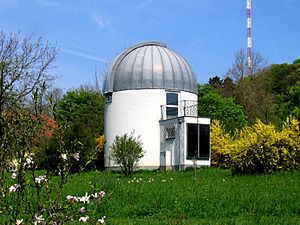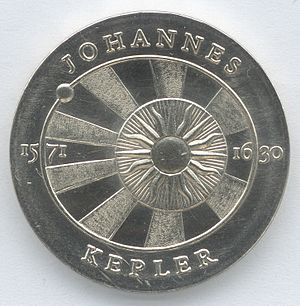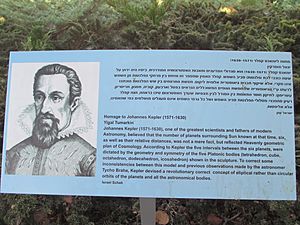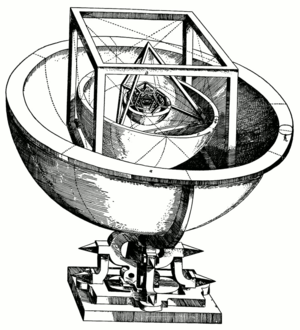Johannes Kepler facts for kids
Quick facts for kids
Johannes Kepler
|
|
|---|---|

Portrait of Kepler by an unknown artist, 1610
|
|
| Born | December 27, 1571 |
| Died | November 15, 1630 (aged 58) Regensburg, Electorate of Bavaria, Holy Roman Empire
|
| Nationality | German |
| Alma mater | Tübinger Stift, University of Tübingen |
| Known for | Kepler's laws of planetary motion Kepler conjecture Rudolphine Tables |
| Scientific career | |
| Fields | Astronomy, astrology, mathematics and natural philosophy |
| Doctoral advisor | Michael Maestlin |
| Influences | Nicolaus Copernicus Tycho Brahe |
| Influenced | Sir Isaac Newton |
| Signature | |
Johannes Kepler (born December 27, 1571 – died November 15, 1630) was a smart German scientist. He was a mathematician, an astronomer, and even an astrologer.
Kepler was very important during the 17th-century scientific revolution. He is most famous for his laws of planetary motion. These laws explain how planets move around the Sun. His ideas also helped Isaac Newton create his theory of universal gravitation, which explains gravity.
Contents
Kepler's Early Life and Learning
Johannes Kepler was born on December 27, 1571. This was the feast day of St John the Evangelist. He was born in a place called Weil der Stadt, which is now part of Germany.
He loved astronomy from a young age. When he was six, his mother took him to see the Great Comet of 1577. He remembered being "taken by [his] mother to a high place to look at it." At age nine, he saw a lunar eclipse. He recalled being "called outdoors" to see the moon "appeared quite red." Sadly, childhood smallpox made his eyesight weak and crippled his hands. This made it hard for him to do hands-on astronomy observations.
In 1589, Kepler went to the University of Tübingen. He studied philosophy and theology there. He was a brilliant mathematician. He also became known for being a good astrologer. He would create horoscopes for his fellow students.
He learned about two main ideas of how planets moved. One was the Ptolemaic system, which said Earth was the center. The other was the Copernican system, which said the Sun was the center. Kepler believed in the Copernican system. He argued that the Sun was the main power source in the universe.
Even though he wanted to be a minister, Kepler was offered a job. He became a teacher of mathematics and astronomy. This was at a Protestant school in Graz. He took the job in April 1594, when he was 23.
Kepler's Career and Discoveries
Kepler worked as a mathematics teacher in Graz. He later became an assistant to the famous astronomer Tycho Brahe in Prague. Eventually, he became the main mathematician for Emperor Rudolf II. He also worked for the next two emperors.
His main job for the emperor was to give astrological advice. He made horoscopes for leaders. The emperor also asked for his advice during political problems. Rudolf was very interested in the work of his court scholars. This included Kepler's studies in astronomy.
Kepler also taught mathematics in Linz. He advised General Wallenstein. He did important work in optics, which is the study of light. He even invented a better refracting telescope, called the Keplerian telescope. His work was mentioned by his friend Galileo Galilei, who also made telescope discoveries.
In Kepler's time, astronomy and astrology were not clearly separated. But astronomy and physics were seen as very different. Kepler believed God created the world with a plan. He thought this plan could be understood through reason. He called his new astronomy "celestial physics."
Many people see Kepler as a very modern scientist. The science popularizer Carl Sagan called him "the first astrophysicist and the last scientific astrologer."
Kepler's Family Life
In December 1595, Kepler met Barbara Müller. She was a 23-year-old widow with a young daughter. Johannes and Barbara got married on April 27, 1597.
In their early marriage, they had two children, Heinrich and Susanna. Sadly, both died when they were babies. Later, they had a daughter named Susanna in 1602. They had a son named Friedrich in 1604, and another son, Ludwig, in 1607.
Kepler's Important Books
Mysterium Cosmographicum
Kepler's first big astronomy book was Mysterium Cosmographicum (The Cosmographic Mystery), published in 1596. It was the first book to strongly support the Copernican system. In it, Kepler tried to find a rule connecting the size of each planet's path to how long it took to orbit. He later realized this rule was not exact enough.
Kepler believed Mysterium showed God's geometric plan for the universe. His strong belief in God's plan made him excited about the Copernican system. He thought there was a deep connection between the physical world and the spiritual world.
In 1621, Kepler published a new, bigger version of Mysterium. He added notes explaining his corrections and improvements over 25 years. This book was a key step in updating Copernicus's ideas.
Astronomia Nova

In this book, Kepler introduced a new idea: planetary orbit. This was the path a planet takes in space because of physical forces. Before, people thought planets were attached to clear, spherical shells. Kepler's idea meant that physical laws controlled how planets moved.
Kepler believed the Sun was like God the Father and was the source of power in the Solar System. He thought the Sun's power got weaker farther away. This made planets move faster when closer to the Sun and slower when farther away. He also found that a planet's speed was linked to its distance from the Sun.
In this book, Kepler also wrote his first law of planetary motion. It says that all planets move in ellipses, with the Sun at one focus. An ellipse is like a stretched circle.
Epitome of Copernican Astronomy
The Epitome included all three of Kepler's laws of planetary motion. It tried to explain how planets moved using physical reasons. Kepler thought that spinning objects make their moons or planets revolve around them. So, the Sun's spin makes planets orbit, and Earth's spin makes the Moon orbit. He also said that this force gets weaker with distance. This means objects farther away from the center move slower.
Kepler finished the first part of this book by 1615. It was printed in 1617. But the Catholic Church banned Copernican books. Also, the Thirty Years' War started. This delayed the other parts. The second part came out in 1620, and the third in 1621.
Rudolphine Tables
After Astronomia Nova, Kepler spent most of his time on the Rudolphine Tables. He finished them in 1623. This was seen as his most important work at the time. But because of publishing rules and talks with Tycho Brahe's family, it wasn't printed until 1627. These tables were very accurate for predicting planet positions.
Astronomiae Pars Optica
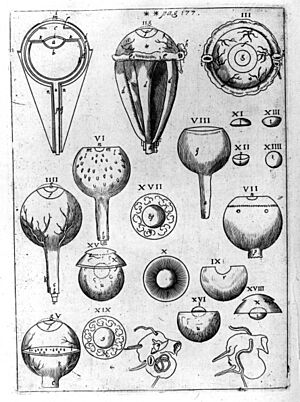
In 1603, Kepler focused on the study of light. He published his findings in Astronomiae Pars Optica (The Optical Part of Astronomy). In this book, Kepler explained how light intensity decreases with distance. He also described how light reflects off mirrors and how pinhole cameras work. He looked at how optics affected astronomy, like parallax and the size of heavenly bodies.
He also studied the human eye. Scientists today believe he was the first to realize that the eye's lens projects images upside down and backward onto the retina. Kepler thought the brain corrected this image.
Today, Astronomiae Pars Optica is seen as the start of modern optics.
Kepler's Work in Math and Physics

In 1613, Kepler wrote an important math book called Nova stereometria doliorum vinariorum. It was about measuring the volume of containers, like wine barrels. This book was published in 1615. Kepler also helped develop new math methods. These included ways to find very small changes and early uses of logarithms. His work on calculating volumes was a big step toward creating calculus.
How Kepler Influenced Culture
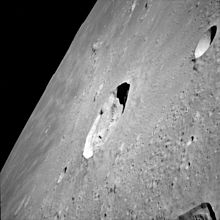
Kepler is seen as a symbol of modern science. Carl Sagan called him "the first astrophysicist and the last scientific astrologer."
Many things are named after Kepler because of his contributions to science:
- Kepler's laws of planetary motion
- Kepler's Supernova (a star explosion he observed)
- The Kepler–Poinsot polyhedra (geometric shapes)
- The Kepler conjecture (a math problem about stacking spheres)
Places and objects named in his honor include:
- City streets and squares
- Schools
- An asteroid
- Craters on the Moon and Mars
Books Written by Kepler
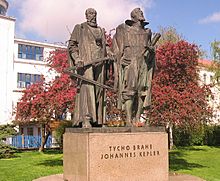
- Mysterium cosmographicum (The Sacred Mystery of the Cosmos) (1596)
- Astronomia nova (New Astronomy) (1609)
- Epitome astronomiae Copernicanae (Summary of Copernican Astronomy) (published in three parts from 1618-1621)
- Harmonice Mundi (Harmony of the Worlds) (1619)
- Mysterium cosmographicum (The Sacred Mystery of the Cosmos) 2nd Edition (1621)
- Tabulae Rudolphinae (Rudolphine Tables) (1627)
- Somnium (The Dream) (1634)
Images for kids
-
Karlová street in Old Town, Prague – house where Kepler lived. Now a museum.
-
A statue of Kepler in Linz
-
The GDR stamp featuring Kepler
See also
 In Spanish: Johannes Kepler para niños
In Spanish: Johannes Kepler para niños


